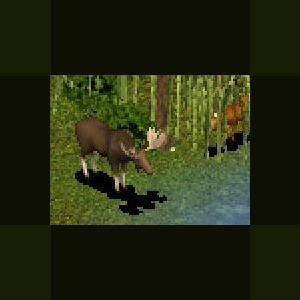About This File
Eurasian Elk
Author: Ghirin
http://www.zoo-tek.com/forums/index.php?download=110
The majestic elk is the largest member of the deer family, measuring up to 7.5 feet in height. They can be found throughout the northern forests of North America, Europe, and Russia. Male elk (bulls) are much larger than female elk (cows); a large bull can weigh up to twice as much as a typical cow. During most of the year, the bull is distinguished by a magnificent set of antlers, having an average spread of 4 to 5 feet and as many as 30 tines. The shape of these antlers is unique to the individual. Mature males shed their antlers once a year in the winter and replace them with larger ones. Other characteristics of the elk include large muscular shoulders, a "bell" or dewlap of skin under the chin, a drooping nose, long legs, and a small tail.
Elk are a very hardy and adaptable species, wintering successfully in some of the coldest regions of the world. There is some confusion surrounding this animal's name: whereas an elk is always an elk, an elk is called a moose in North America, and an elk in America is a different species known in Europe as a red deer.
In the wild, elk occupy a wide variety of different habitats, ranging from densely forested areas, to swampy areas around bogs and streams, to open forest-tundra regions. A typical elk habitat might be a forested area that contains a water source and abundant plant life. Elk enjoy munching on a wide variety of foliage, with a particular fondness for willow. An adult elk consumes an average of 44 pounds of plants a day, but will eat more in spring and autumn. In the autumn, they can consume as much as 130 pounds a day.
Elk have poor vision, which is compensated for by acute hearing and smell. They are swift runners, reaching speeds of up to 35 miles an hour. They are also excellent swimmers and can dive a considerable depth, having valvular nostrils, which seal upon submergence.
Elk are solitary animals, except during the rutting season. The strongest social bond is between mother and young. They do not like crowding. They will generally avoid humans, but can be unpredictable and dangerous under certain conditions. For instance, cows with calves and rutting bulls have been known to charge people, cars, horses, and even locomotives.
During the fall rut, bulls compete for mates by bringing their antlers together and shoving. Generally quiet creatures, both sexes give out a cow-like moo during this season. Elk reproduce well and can quickly fill their habitat to capacity if they are not limited by predation and hard winters. When food supplies are abundant, cows will frequently give birth to twins or even triplets. In the spring, last year's offspring will be driven off by the cow as she prepares to give birth again.
A healthy adult elk has little to fear from most animals. The two main predators of elk are bears and wolves. Many more elk fall to humans, as these animals are a favorite target for big game hunters. The primary limiting factor of elk populations is habitat. A harsh winter will greatly increase elk mortality.
*Inspired by the Zoo Tycoon Brains Trust. (http://www.geocities.com/professorpaul1/home.html)
Created by Ghirin 2003
Updated 2010-11-03
Just to save space with less in zip and smaller image.
Nothing new.



Recommended Comments
There are no comments to display.
Create an account or sign in to comment
You need to be a member in order to leave a comment
Create an account
Sign up for a new account in our community. It's easy!
Register a new accountSign in
Already have an account? Sign in here.
Sign In Now